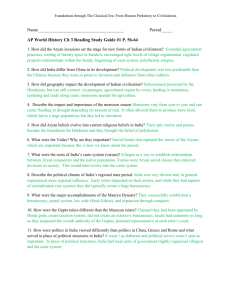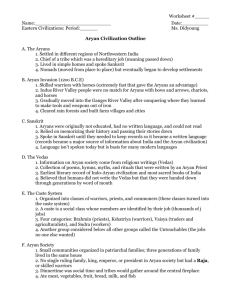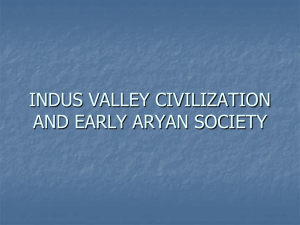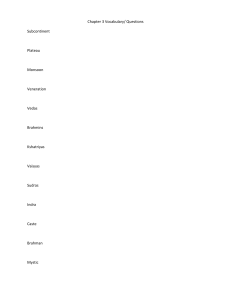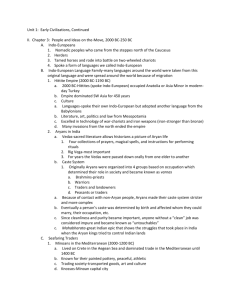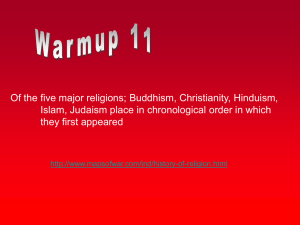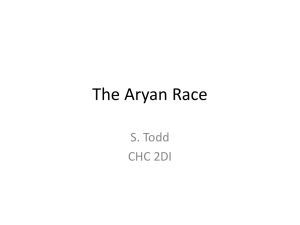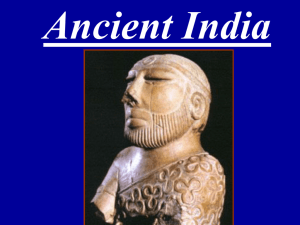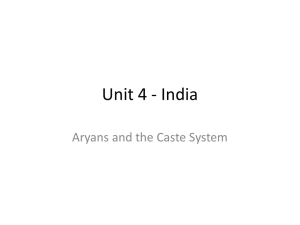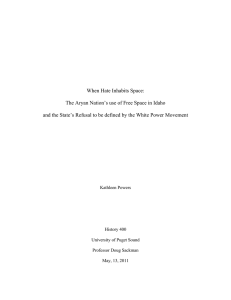K12historywhi4aryanmigration
advertisement
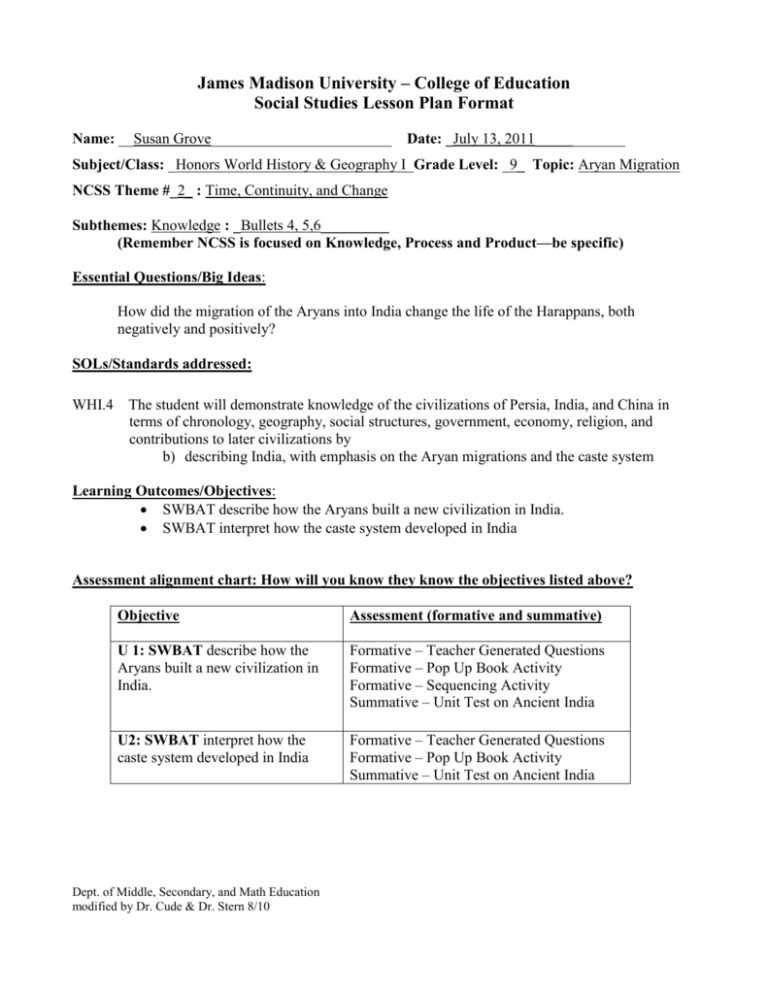
James Madison University – College of Education Social Studies Lesson Plan Format Name: __Susan Grove________________________ Date: _July 13, 2011____________ Subject/Class: _Honors World History & Geography I_Grade Level: _9_ Topic: Aryan Migration NCSS Theme #_2_ : Time, Continuity, and Change Subthemes: Knowledge : _Bullets 4, 5,6_________ (Remember NCSS is focused on Knowledge, Process and Product—be specific) Essential Questions/Big Ideas: How did the migration of the Aryans into India change the life of the Harappans, both negatively and positively? SOLs/Standards addressed: WHI.4 The student will demonstrate knowledge of the civilizations of Persia, India, and China in terms of chronology, geography, social structures, government, economy, religion, and contributions to later civilizations by b) describing India, with emphasis on the Aryan migrations and the caste system Learning Outcomes/Objectives: SWBAT describe how the Aryans built a new civilization in India. SWBAT interpret how the caste system developed in India Assessment alignment chart: How will you know they know the objectives listed above? Objective Assessment (formative and summative) U 1: SWBAT describe how the Aryans built a new civilization in India. Formative – Teacher Generated Questions Formative – Pop Up Book Activity Formative – Sequencing Activity Summative – Unit Test on Ancient India U2: SWBAT interpret how the caste system developed in India Formative – Teacher Generated Questions Formative – Pop Up Book Activity Summative – Unit Test on Ancient India Dept. of Middle, Secondary, and Math Education modified by Dr. Cude & Dr. Stern 8/10 Background Content Outline: The Aryan Invasion I. The Aryans A. Came from 1. Europe 2. Asia B. Reasons for migration into India 1. Seek water 2. Seek pasture C. The Vedas 1. A collection of hymns, prayers and other religious teachings 2. Memorized by priests for 1000 years before written down 3. Sometime referred to as Vedic Age II. Aryan Society and Religion A. Caste System 1. 4 basic groups a. Brahmins – priests b. Kshatriyas – warriors c. Vaisyas – herders, farmers, merchants, artisans d. Sudras – non-Aryan laborers, farm laborers 2. Reflected social and economic roles more than racial differences B. Belief in one god with many forms 1. Gods and goddesses based on a. Nature b. Animals 2. Major gods a. Indra – god of war b. Varuna – god of order and creation c. Agni – god of fire 3. Mysticism A. People who devote their lives to seeking spiritual truth B. Yoga, meditation, etc – seeking communication with divine Forces III. Expansion and Change A. Rajah 1. Chief of a tribe or kingdom 2. Strongest warrior – elected by tribesmen B. Settled down 1. Begin farming and cattle raising 2. Settled in the Ganges Basin 3. Learn to make iron weapons 4. Develop Sanskrit IV. Literature A. Mahabharata 1. The greatest Indian epic Dept. of Middle, Secondary, and Math Education modified by Dr. Cude & Dr. Stern 8/10 2. Almost 100,000 verses 3. Told of Aryan tribal fights for control of Ganges Basin 4. Bhagavad Gita a. Part of Mahabharata b. Reflect important Indian religious beliefs B. Ramayana 1. Tells story of hero Rama and his bride Sita 2. Very similar to the Greek epics by Homer DEAN CHART Concept word Caste D=define Class of person in Ancient India based on occupation E=examples Class system A=attributes Based on occupation Still in place today though illegal N=non-examples Instructional Plan: What the Teacher Will Do Hook/ 1. Teacher will give out “Sherando Invades” Introduction reading about SHS closing and their students 10 minutes coming to James Wood and ask students to read and be prepared to reply. 2. Teacher will ask for student’s reaction. Lecture/ Discussion 20 minutes Activity 50 minutes Closing 10 minutes 3. Teacher will introduce the lesson on the Aryan migration. 1. Teacher will lead a lecture/discussion on the Aryan migration checking for understanding with guided oral questions. 1. Teacher will handout laptops and direct students to www.zooburst.com. 2. Teacher will handout instruction sheet and explain how to login to website and create a popup book that tells the story of the Aryan migration or explains the workings of the caste system. The instructions will include a rubric for the pop-up book. 3. Teacher will move throughout classroom assisting as needed as students create project. 1. Teacher will hand out placards with an event concerning the Aryan migration listed on each placard. 2. Teacher will give students instructions to stand Dept. of Middle, Secondary, and Math Education modified by Dr. Cude & Dr. Stern 8/10 What the Students Will Do 1. Students will read “Sherando Invades.” 2. Students will share reactions with class. 1. Students will take notes on lecture/discussion. 1. Students will log on to laptops. 2. Students will listen to instructions and ask pertinent questions. 3. Students will create a pop up book on www.zooburst.com. 1. Students with placards will arrange themselves in chronological order. 2. Students will explain how and place themselves in chronological order. 3. Teacher will ask students remaining in seats to explain how one event relates to the next. the first event connects to the next in chronological order. Materials Needed for the Lesson: Sherando Invades Handouts Lecture Notes Laptop Cart Zooburst Directions and Rubric Handouts Sequencing Placards Bibliography/Resources Used (using APA): Edgerton, Roxanne (6/30/11). Hands on History. Content Academy History K-12. Lecture conducted from James Madison University, Harrisonburg, VA Woolever, Tara (6/28/11). Tools, Tips, Technology to Teach Politics. Content Academy History K12. Lecture conducted from James Madison University, Harrisonburg, VA Adaption/Differentiation: ELL/struggling Notes given through handouts or fill in the blank worksheets. readers ADHD Adjust notes portion of lesson to a student led smart activity that keeps students moving in the classroom. Gifted This lesson was created for an honors class. Explanation of Instructional Strategies Used: The Sherando Invades Activity allows students to imagine what it would be like to have outsiders come in and essentially overrun their home. It makes them think about how they would react and allows the teacher to throw up roadblocks to their plans so that they are forced to come up with new solutions. The lecture provides the opportunity to present material while honors students work on note taking skills we have begun working on at this point of the year. It also allows for the teacher to check for understanding as the material is being presented. The pop up book allows for students to use technology to create a creative interpretation of the topic of the Aryan migration. The sequencing activity is a chance to make sure students have the information and also to pick up on any weak areas that may need further review during the next class period. Dept. of Middle, Secondary, and Math Education modified by Dr. Cude & Dr. Stern 8/10
